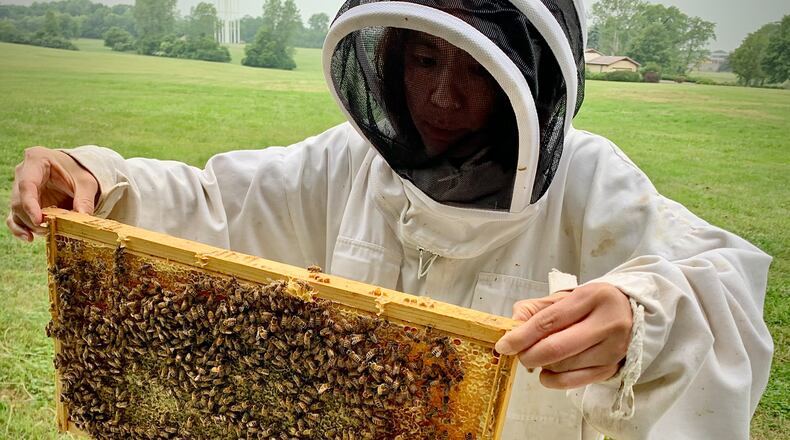The university received $634,695 in competitive sustainable farming grant dollars from the USDA in 2020, and more than $9 million from the USDA in total. By 2022, the competitive sustainable farming grant dollars had increased to more than $12 million, and the university had received nearly $26 million in total from the USDA in 2022, which includes one grant that totaled about $10 million.
So far in 2023, the university has gotten about $1.7 million in competitive USDA sustainability grants and about $17 million total from the USDA.
Bee research
One example of sustainable agriculture research at Central State is work on bees, a key pollinator.
Hongmei Li-Byarlay, research associate professor of entomology at Central State, is researching the genetics of bees to better understand the insects and see how breeding affects colonies.
“There’s a decline in honeybee populations, and as managed pollinators, they are definitely very important for our crop production and food security,” said Li-Byarlay.
Li-Byarlay said bees are key for fruits and vegetable production because they help plants reproduce.
“People want to drink beer, but the beer is made from hops and hops are pollinated by bees,” she said.
Honeybees are threatened by a loss of habitat, but also by a parasitic mite that, if left alone, can kill a bee colony. Li-Byarlay has been researching wild bees, which have a high biting behavior that can kill the mites, and how they can be bred for commercial availability.
Other research with bees includes genetic sequencing, breeding and seeing how bees respond to various types of pesticides.
Keiana Briscoe, one of Li-Byarlay’s research students, said she didn’t know much about bees before joining the research on bees. The research experience she got working on the project was invaluable, she said.
“It helped me as a student and as a researcher,” she said.
Hemp research
Craig Schluttenhofer, research assistant professor of natural products at Central State, says hemp can be used in crop rotation in the future for farmers. Its uses include several food products, fiber products and could be used to raise animals.
Rotating crops is good for soil management, but also helps keep down pests and reduce diseases.
Schluttenhofer said that one of the issues with growing hemp now, though, is that there isn’t the same commercial processing availability as there is for other crops, like soybeans and corn.
While hemp is now legalized and there are commercial uses for it with CBD oil and extracts, the parts of hemp usage that include creating fuel, food products and textiles don’t exist at the same level as the processing for corn and soybeans.
“The companies won’t set up a facility unless they know they have growers, or the growers aren’t going to grow it unless they know they have somebody to sell to,” Schluttenhofer said.
Schluttenhofer said he always has students involved in the work, which includes planting and cultivating. That helps prepare the students for graduate school, he said.
“Just diversifying and getting hands on experience for their educational experience here at Central State provides a number of benefits,” he said.
About the Author

